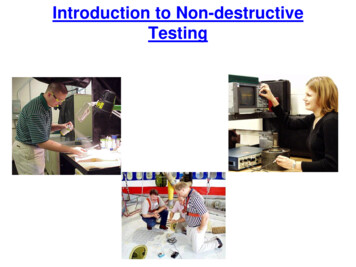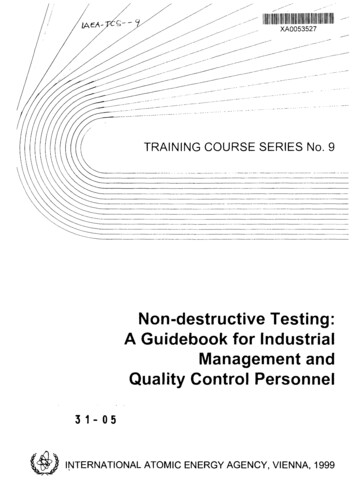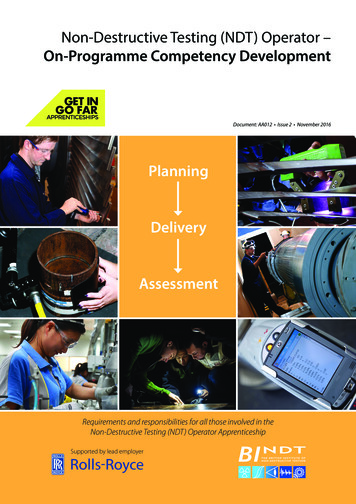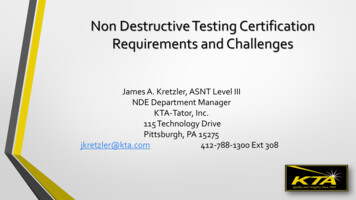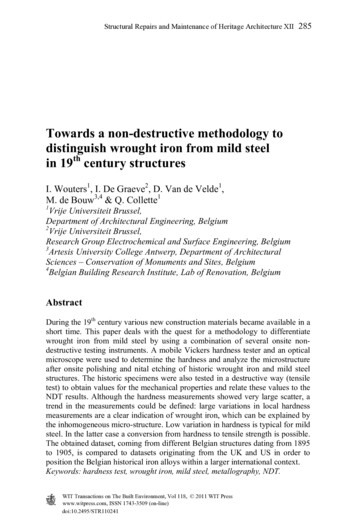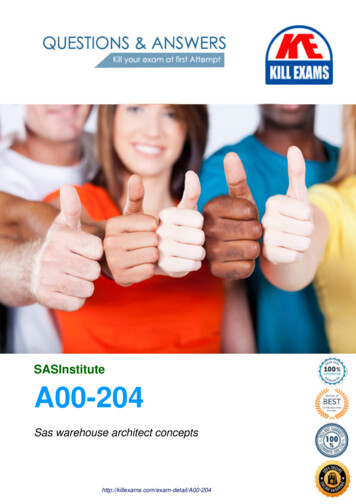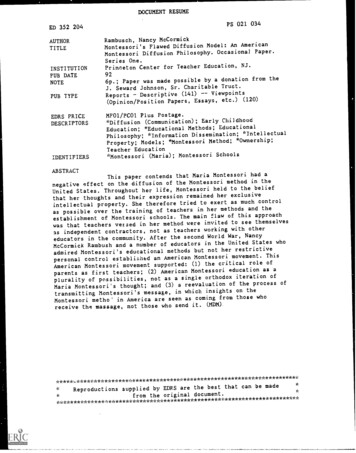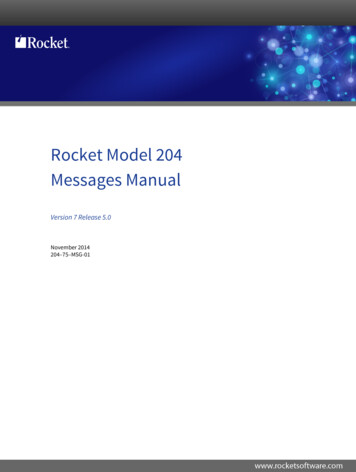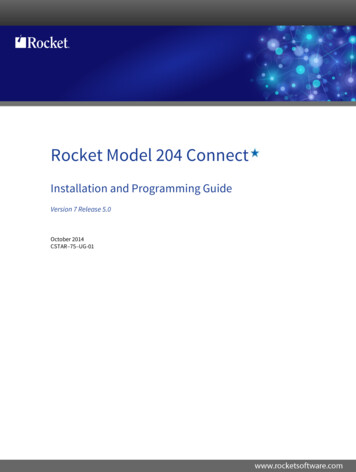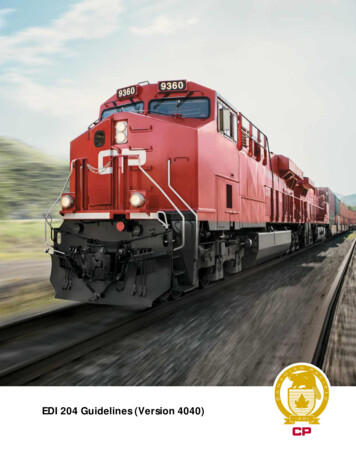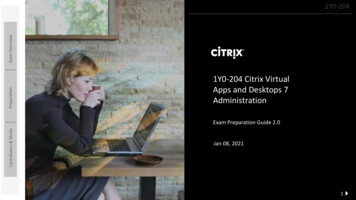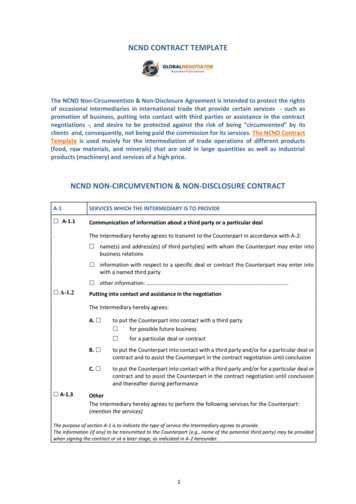
Transcription
WLD 204Non Destructive Testing IVisual TestingNSF-ATE ProjectAdvanced Materials Joining for Tomorrow’s Manufacturing Workforce
INDEXVisual InspectionGeneral Information2-3Visual InspectionArticles4-16Visual InspectionHomework17-20Visual InspectionQuizzes21-23Visual InspectionWelding Defects24-42Visual InspectionASME Procedure43-63Visual InspectionLabs64-6667Visual InspectionExamination Report SheetThis project was supported, in part,by theNational Science FoundationOpinions expressed are those of the authorsAnd not necessarily those of the FoundationNSF-ATE ProjectAdvanced Materials Joining for Tomorrow’s Manufacturing Workforce1
VISUAL INSPECTION (VT)With practice and experience you will learn to uncover a vast amount of information about a weld byvisually examining the surface. Such discontinuities as undercut, cracks, surface porosity, inadequateroot penetration, and improper dimensions, improper joint prep, improper fit-up or profiles can easily beseen with the eye. Even such things as improper technique by the welder can be detected by studying theweld with a trained eye. We will talk more about the trained eye after showing some advantages andlimitations of visual inspection.The Trained Eye (See Article The Case for Eye Test Standardization by William H. Bailey)A person with a trained eye is someone who has really learned to see detail. At first, most of us assumethat is an easily acquired skill and say, "I can see all right. Nobody needs to tell me how to see." But asyou work with a skillful inspector, you might find yourself saying, "I really didn't see that before. Ididn't know that you could tell so much about a weld just by looking at it."A prerequisite to visual inspection is an eye examination and correction of vision (glasses) if necessary.You might call this examination the calibration of your eye. It merely verifies that you can see with agiven sensitivity.The next step in visual examination is learning what discontinuities are possible to detect visually, andlearning where these will normally show up. For example, undercut occurs along the toe of the bead. Itis seen as a groove alongside the weld that may be caused by the amperage being too high or otherimproper welding techniques.The third aspect of visual inspection is realizing that you cannot see everything with the naked eye, letalone find the smaller discontinuities. There are many devices you can use to help see them. The othermethods of nondestructive testing we will talk about are extensions of the eyes. They help in locatingand seeing smaller and less distinct discontinuitiesOnce the weld is completed, the acceptance inspection for discontinuities, dimensional accuracy(including distortion), conformity to drawings, and weld appearance (roughness, spatter, etc.) shouldtake place. The thoroughness of this review should be aided by using the other nondestructive inspectionmethods, as dictated by your judgment or as called for in the specification documents.Improper fit-up undercut, surface porosity, cracks open to the surface, bead contour, and overlap aresome typical discontinuities that can be seen with the naked eye.Note that visual inspection, besides being the least expensive of the nondestructive methods, may resultin the greatest cost savings. Visual inspection before and during deposition of any weld metal maysubstantially reduce the overall cost of fabrication. For instance, ultrasonic testing of a weld joint with aborderline indication due to lack of back gouging is very slow and expensive. This ability to eliminatemany discontinuities before the weld is completed is perhaps the most important feature of visualinspection.NSF-ATE ProjectAdvanced Materials Joining for Tomorrow’s Manufacturing Workforce2
Advantages1. Visual inspection is used before, during, and after fabrication of any weldment.2. Visual inspection will show most large discontinuities and will generally point to other discontinuitiesthat must be detected by another method.3. Visual inspection can detect and aid in eliminating discontinuities that might become defects in thecompleted weldment.4. Visual inspection costs less than any other nondestructive inspection method.Limitations1. The value of visual inspection depends largely on the experience and welding knowledge of theinspector. The inspector should be familiar with design and weld requirements.2. Visual inspection is limited to detection of surface discontinuities.3. Visual inspection started too late in the sequence of welding operations cannot detect improper jointfit-up or other costly deviations from best welding practice.NSF-ATE ProjectAdvanced Materials Joining for Tomorrow’s Manufacturing Workforce3
NSF-ATE ProjectAdvanced Materials Joining for Tomorrow’s Manufacturing WorkforcePermission to copy requested from American Society of Nondestructive Testing4
NSF-ATE ProjectAdvanced Materials Joining for Tomorrow’s Manufacturing WorkforcePermission to copy requested from American Society of Nondestructive Testing5
NSF-ATE ProjectAdvanced Materials Joining for Tomorrow’s Manufacturing WorkforcePermission to copy requested from American society of Nondestructive Testing6
NSF-ATE ProjectAdvanced Materials Joining for Tomorrow’s Manufacturing WorkforcePermission to copy requested from American Society of Nondestructive Testing7
NSF-ATE ProjectAdvanced Materials Joining for Tomorrow’s Manufacturing WorkforcePermission to use requested from Welding Design & Fabrication Verbally granted8
NSF-ATE ProjectAdvanced Materials Joining for Tomorrow’s Manufacturing WorkforcePermission to use requested from Welding Design & Fabrication Verbally granted9
NSF-ATE ProjectAdvanced Materials Joining for Tomorrow’s Manufacturing WorkforcePermission to use requested from Welding Design & Fabrication Verbally granted10
NSF-ATE ProjectAdvanced Materials Joining for Tomorrow’s Manufacturing WorkforcePermission to use requested from Welding Design & Fabrication Verbally granted11
NSF-ATE ProjectAdvanced Materials Joining for Tomorrow’s Manufacturing WorkforcePermission to use requested from Welding Design & Fabrication Verbally granted12
NSF-ATE ProjectAdvanced Materials Joining for Tomorrow’s Manufacturing WorkforcePermission to use requested from Welding Design & Fabrication Verbally granted13
NSF-ATE ProjectAdvanced Materials Joining for Tomorrow’s Manufacturing WorkforcePermission to use requested from Welding Design & Fabrication Verbally granted14
NSF-ATE ProjectAdvanced Materials Joining for Tomorrow’s Manufacturing WorkforcePermission to use requested from Welding Design & Fabrication Verbally granted15
NSF-ATE ProjectAdvanced Materials Joining for Tomorrow’s Manufacturing WorkforcePermission to use requested from Welding Design & Fabrication Verbally granted16
VT HW 11.What is the most extensively used Nondestructive Testing Method (NDT)?A.B.C.D.2.using Ultrasonic Inspectionusing a lamination gaugeby inspecting a cut edgeA and BAfter a part has been fit up and is in position to be welded, the visual inspector should inspect thefollowing to assure the quality of the welded joint. (select more than one)A.B.C.D.6.TrueFalseUsing Visual examination how can plate laminations be observed?A.B.C.D.5.requires no special equipmentvery time consuminginexpensiverequires good eyesightBecause visual inspection is the simplest of the NDT methods definite procedures are notrequired only common sense and the possession of the proper code book are necessaryA.B.4.Radiographic Testing (RT)Ultrasonic Testing (UT)Visual Testing (VT)General TestingWhich of the following is not a feature of Visual Inspection?A.B.C.D.3.Name:root openingedge preparationweld metal tensile strengthdensity of the base metalBecause of the large number of variables that can cause defects, which weld layer or pass isconsidered the most important?A.B.C.D.root passhot passfill passcap passNSF-ATE ProjectAdvanced Materials Joining for Tomorrow’s Manufacturing Workforce17
7.From the list below which is (are) weld defects that cannot be detected by visual inspection?A.B.C.D.8.Which weld cleaning operation from the list below, may harm the surface of the weld and masksurface defects?A.B.C.D.9.prior to weldingduring weldingafter weldingall of the aboveSelect those items from the list below that are considered limitations of visual inspection (VT).A.B.C.D.12.a distinctive color should be usedeasy to applymarking material that will not damage materialPermanent enough so that repair and reinspection can take placeFor visual inspection to be a valuable welding tool, it should take place?A.B.C.D.11.chipping hammershot blastingpower wire brushingall of the aboveSelect from the list below, the feature that is not desirable, when marking a weld for repair.A.B.C.D.10.undercutcracksoverlapslag inclusionsrequires little trainingeconomicaldefects must be on surfacemany applicationsWhich type of weld does a visual welding inspector determine the weld size by measuring itsleg?A.B.C.D.Butt weldSpot weldPipe weldFilletNSF-ATE ProjectAdvanced Materials Joining for Tomorrow’s Manufacturing Workforce18
13.When acceptance of welds with regard to appearance is a major factor the visual inspector mayuse.A.B.C.D.14.When detailed written visual procedures are not available, the inspector maybe required to workdirectly with:A.B.C.D.15.C.D.add cost to a project and should be avoidedwill allow visual inspection of the exposed surfaces as they occur in the fabricationsequenceassure a 100 % defect free projectnone of the aboveWhat is a hold point as applied to visual examination?A.B.C.D.17.his own insight and ideas of what is acceptablecodesspecificationsB and CAny conscientious quality control program consisting of visual inspection, which includes acontinual sequence of examinations performed during all phases of fabrication will:A.B.16.a workmanship standardanother NDT methodan appearance gagenone of the abovethe fabrication will hold up a project until additional payments are madea welder must hold the electrode at a set angle or hold pointa point in time where an examination is to occur prior to any further workthe end of a jobVisual examination of joint fit-up, prior to welding is of the highest priority. Which items fromthe list below should be inspected by the visual inspector? (select more than one)A.B.C.D.E.F.groove angleroot passjoint alignmentconvexityjoint cleanlinessmaximum weld reinforcementNSF-ATE ProjectAdvanced Materials Joining for Tomorrow’s Manufacturing Workforce19
18.From the list below select the items that a visual welding inspector would perform duringwelding that require the aid of a special tool.A.B.C.D.19.What type of weld defect can be avoided with adequate cleaning between weld passes?A.B.C.D.20.quality of rootsequence of weld passescleaning between passesinterpass temperatureslag inclusionsoverlapincomplete joint penetrationcracksThe type of weld discontinuities, which can be detected by visual examination and are almostnever allowable when the structure is subject to cyclic or fatigue loading are?A.B.C.D.overlapscracksslag inclusionsporosityNSF-ATE ProjectAdvanced Materials Joining for Tomorrow’s Manufacturing Workforce20
VT QUIZ 1Name:1. Visual inspection is a method of .2. Nondestructive testing does not destroy or impair the usefulness of the materials being tested.A.TrueB.False3. Inherent discontinuities occur during .4. Lamination occur in bar stock.A.TrueB.False5. Welding pipe and tubing is formed by drawing a flat strip of metal through aor sets of .6. Weld metal in excess of the quantity require to fill the joint is called the.7. The heat affected zone is the area of the base metal which has been melted.A.TrueB.False8. Dirt or moisture on the surface of the base metal or contaminated welding consumables cancause .9. Undercut, under fill and overlap are easily detected by inspection.10. Arc strikes may require removal by grinding and inspection by.11. Arc welding requires a protective atmosphere to protect the weld from.12. Inclusions are classed as and .13. Rule or scale accuracy is limited toa.b.c.d.015.001.0015.005NSF-ATE ProjectAdvanced Materials Joining for Tomorrow’s Manufacturing Workforce21
14. Protractors are used to measurea. thickness of steel plateb. thread pitchc. depth of holes and recessesd. angular relationships15. Weld inspection gages measurea. weld preparation anglesb. height of weld metalc. length of weldd. a and b above16. The accuracy of a venire micrometer isa.b.c.d.001.0001.005.01017. Consistent accuracy is dependent on thea.b.c.d.strength of the inspectorsense of sightsense of feelboth b and c18. The numbered lines on the micrometer barrel or sleeve representsa.b.c.d.100, .200, .300.001, .002, .003.01, .02, .031000, 2000, 300019. Telescoping gages measurea.b.c.d.outside diametersurface finishinside diametersfillets and radii20. The weld gage will measurea. Undercutb. Filler metal typec. Weld metal temperatured. Area of heat affected zoneNSF-ATE ProjectAdvanced Materials Joining for Tomorrow’s Manufacturing Workforce22
21. A visual inspector’s most valuable asset is .22. Illumination intensity is measured in .23. Flashlights and extension-drop lights provide .24. Power of a magnifier is designated by the letter .25. The flexible bore scope operates entirely with .NSF-ATE ProjectAdvanced Materials Joining for Tomorrow’s Manufacturing Workforce23
WELDING DEFECTSA listing and description of defects important to weld quality is presented, with notes on appearance,cause, and effect, emphasizing radiographic appearance and interpretation from radiographic film.Although radiograp
4. Visual inspection costs less than any other nondestructive inspection method. Limitations 1. The value of visual inspection depends largely on the experience and welding knowledge of the inspector. The inspector should be familiar with design and weld requirements. 2. Visual inspection is limited to detection of surface discontinuities. 3 .
